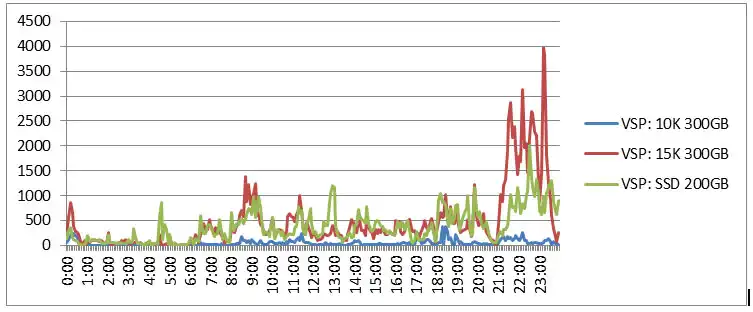In previous blogs we talked about metrics that we would like to see added to RMF and SMF records. We also discussed the challenges that EMC and HDS face fitting their measurement data in the IBM-defined RMF instrumentation.
A good example of what can be achieved given the constraints is what HDS did for their Hitachi Dynamic Provisioning (HDP) pools. HDP pools are the basis for thin provisioning and dynamic tiering in the Hitachi architecture. An HDP pool consists of a number of array groups. Arrays with different drive technologies can be combined in a pool with dynamic tiering, in a mix that you feel is appropriate for your workload.
With the introduction of the HDP pools, HDS decided to assign ‘IBM extent pool’ numbers to each HDP pool. IBM uses a two-byte extent pool number in their architecture. With HDP, HDS now returns hex ‘01xx’ for HDP Pool (hex) xx. Since there can be up to 128 HDP pools in a storage array, this fits nicely.
Like for IBM, each VSP array group or concatenated array group gets a rank number. The 74.8 RMF records provide the relationship between an IBM Extent Pool and its ranks, so for the VSP this gives the relationship between an HDP pool and its arrays.
Sample information for one Dynamic Tiering Pool:
| Strage Pool | RAID Group ID | # Drives | Drive Tier | RAID Type |
| HDP 00 | 0001: 1-1 | 4 | USP: SSD 200GB | RAID 5 |
| HDP 00 | 000E: 1-14 | 8 | USP: 15K 300GB | RAID 5 |
| HDP 00 | 000F: 1-15 | 8 | USP: 15K 300GB | RAID 5 |
| HDP 00 | 0027: 3-7 | 8 | USP: 10K 300GB | RAID 5 |
| HDP 00 | 0028: 3-8 | 8 | USP: 10K 300GB | RAID 5 |
| HDP 00 | 0029: 3-9 | 8 | USP: 10K 300GB | RAID 5 |
| HDP 00 | 003A: 4-10 | 8 | USP: 10K 300GB | RAID 5 |
| HDP 00 | 003D: 4-13 | 8 | USP: 15K 300GB | RAID 5 |
| HDP 00 | 003E: 4-14 | 8 | USP: 15K 300GB | RAID 5 |
For array groups that are not part of an HDP pool, extent pool zero (0) is returned. This can be misleading, since each (concatenated) array group acts like an individual extent pool in the sense that z/OS volumes are created on the array group. Those array groups that are not part of an HDP pool are not all in one big pool ‘zero’.
The new support is in particular significant for automatic tiering. Like for the DS8000, you can now see the activity and response time for each tier. And since the array group counters include all activity, this includes the inter- and intra-tier migration activity.
With these counters it is possible to assess whether each tier is getting the I/O intensity that you would expect: high activity on SSD and low activity on SATA. Normally this will be the case because of the skew in almost all workloads: some datasets are very active, others are hardly used. When you put constraints on the dynamic tiering algorithm with policy rules, this might impact the ability of the VSP to achieve optimal balance. It will attempt to use the tiers in the ratio that you specify instead of optimizing. Reports like the above provide a great way to assess whether you provided reasonable and useful objectives.
We are very pleased to see that HDS made these changes. They greatly increase your ability to get insight in the back-end and autotiering workload for the VSP.
IntelliMagic Vision Support for Hitachi VSP G1000 SMF Records from Mainframe Analytics Recorder
This white paper provides new insight into the health of the storage systems using the SMF records created by the Hitachi Virtual Storage Platform G1000 (VSP G1000) Analytics Recorder.
This article's author
Share this blog
Related Resources
IntelliMagic Vision Support for Hitachi VSP SMF Records from Mainframe Analytics Recorder
Learn how to gain insight into the health of the Hitachi Virtual Storage Platforms VSP 5000 series and VSP F/G1x00 storage systems using the SMF records created by the Hitachi Mainframe Analytics Recorder.
From Taped Walls to Your PC: z/OS Configuration Made Simple with Topology | IntelliMagic zAcademy
In this webinar, we explore a technique that integrates diverse data sources from z/OS, presenting them in a clear, concise, and interactive visual format.
Banco do Brasil Ensures Availability for Billions of Daily Transactions with IntelliMagic Vision
Discover how Banco do Brasil enhanced its performance and capacity management with IntelliMagic Vision, proactively avoiding disruptions and improving cross-team collaboration.
Book a Demo or Connect With an Expert
Discuss your technical or sales-related questions with our mainframe experts today


 Dr. Gilbert Houtekamer
Dr. Gilbert Houtekamer